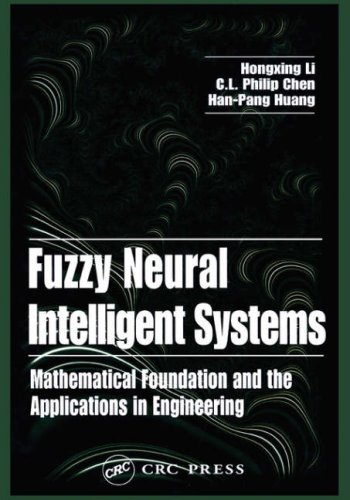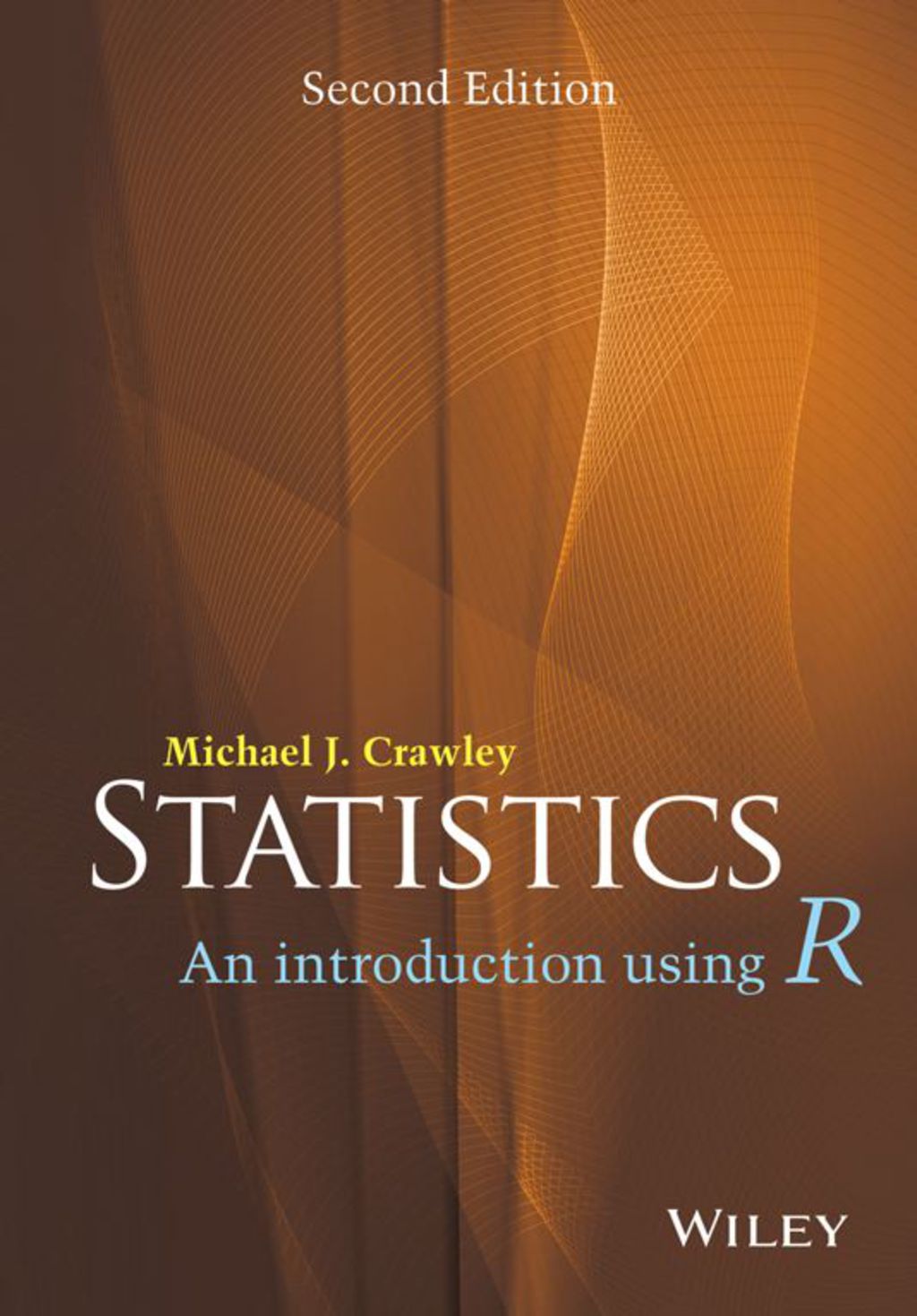Hongxing Li, C.L. Philip Chen, Han-Pang Huang0849323606, 9780849323607
Table of contents :
Fuzzy Neural Intelligent Systems: Mathematical Foundation and the Applications in Engineering……Page 2
Preface……Page 4
Acknowledgments……Page 6
Table of Contents……Page 7
1.1 Definition of Fuzzy Sets……Page 16
Table of Contents……Page 0
1.2 Basic Operations of Fuzzy Sets……Page 21
1.3 The Resolution Theorem……Page 23
1.4 A Representation Theorem……Page 27
1.5 Extension Principle……Page 32
References……Page 37
2.1 A General Method for Determining Membership Functions……Page 38
2.2 The Three-phase Method……Page 42
2.4 The Multiphase Fuzzy Statistical Method……Page 44
2.5.1 Binary Comparisons……Page 46
2.5.2 Preferred Comparisons……Page 47
2.5.3 A Special Case of Preferred Comparisons……Page 48
2.5.4 An Example……Page 49
2.6 The Absolute Comparison Method……Page 50
2.7.2 Basic Steps of Set-valued Statistical Method……Page 53
2.8.2 Creating Order……Page 55
2.8.4 Generalizations……Page 56
2.9.1 The Relative Comparison Method……Page 57
2.9.2 The Mean Pairwise Comparison Method……Page 58
References……Page 61
3.1 Introduction……Page 62
3.2.2 MP Model with Continuous-valued Outputs……Page 63
3.3 The Interpolation Mechanism of Feedforward Neural Networks……Page 67
3.4 A Three-layer Feedforward Neural Network with Two Inputs One Output……Page 71
3.5 Analysis of Steepest Descent Learning Algorithms of Feedforward Neural Networks……Page 73
3.6 Feedforward Neural Networks with Multi-input One Output and Their Learning Algorithm……Page 77
3.7 Feedforward Neural Networks with One Input Multi-output and Their Learning Algorithm……Page 80
3.8 Feedforward Neural Networks with Multi-input Multi-output and Their Learning Algorithm……Page 82
3.9 A Note on the Learning Algorithm of Feedforward Neural Networks……Page 83
3.10 Conclusions……Page 85
References……Page 86
4.1 Discussion of the XOR Problem……Page 87
4.2 Mathematical Essence of Functional-link Neural Networks……Page 90
4.3 As Visualization Means of Some Mathematical Methods……Page 94
4.4 Neural Network Representation of Linear Programming……Page 96
4.5 Neural Network Representation of Fuzzy Linear Programming……Page 101
4.6 Conclusions……Page 102
References……Page 104
5.1 Introduction……Page 105
5.2 The Linear System Equation of the Functional-link Network……Page 106
5.3 Pseudoinverse and Stepwise Updating……Page 108
5.4 Training with Weighted Least Squares……Page 113
5.5 Refine the Model……Page 114
5.6 Time-series Applications……Page 115
5.7 Examples and Discussion……Page 117
5.8 Conclusions……Page 123
References……Page 125
6.1 Definition of Fuzzy Neurons……Page 128
6.2.1 Neural Network Representation of Fuzzy Relation Equations……Page 133
6.2.2 A Fuzzy Neural Network Based on FN……Page 134
6.3 A Fuzzy Learning Algorithm……Page 136
6.4 The Convergence of Fuzzy Learning Rule……Page 138
6.5 Conclusions……Page 139
References……Page 140
7.1 Introduction……Page 141
7.2 A General Criterion on the Stability of Networks……Page 144
7.3 Generalized Energy Function……Page 146
7.4 Learning Algorithm of Discrete Feedback Neural Networks……Page 148
7.5 Design Method of Weight Matrices Based on Multifactorial Functions……Page 150
7.6 Conclusions……Page 152
References……Page 154
8.1 Introduction……Page 155
8.3 Generalized Additive Weighted Multifactorial Functions……Page 156
8.4 Infinite Dimensional Multifactorial Functions……Page 160
8.5 M and Fuzzy Integral……Page 161
8.6 Application in Fuzzy Inference……Page 162
8.7 Conclusions……Page 165
References……Page 166
9.1 Preliminary……Page 167
9.2 The Interpolation Mechanism of Mamdanian Algorithm with One Input and One Output……Page 169
9.3 The Interpolation Mechanism of Mamdanian Algorithm with Two Inputs and One Output……Page 171
9.4 A Note on Completeness of Inference Rules……Page 172
9.5 The Interpolation Mechanism of (+, -)-Centroid Algorithm……Page 173
9.6 The Interpolation Mechanism of Simple Inference Algorithm……Page 174
9.7 The Interpolation Mechanism of Function Inference Algorithm……Page 176
9.8 A General Fuzzy Control Algorithm……Page 177
9.9 Conclusions……Page 178
References……Page 179
10.1 Introduction……Page 180
10.2 The Relationship of Fuzzy Controllers with One Input One Output and P Controllers……Page 181
10.3 The Relationship of Fuzzy Controllers with Two Inputs One Output and PD (or PI) Controllers……Page 184
10.4 The Relationship of Fuzzy Controllers with Three Inputs One Output and PID Controllers……Page 188
10.5.1 Positional Difference Scheme……Page 192
10.5.2 Incremental Difference Scheme……Page 193
10.6 Conclusions……Page 194
References……Page 195
11.1 The Monotonicity of Control Rules and The Monotonicity of Control Functions……Page 196
11.2.1 The Contraction-expansion Factors of Adaptive fuzzy Controllers with One Input and One Output……Page 199
11.2.2 The Contraction-expansion Factors of Adaptive Fuzzy Controllers with Two Inputs and One Output……Page 200
11.3 The Structure of Adaptive Fuzzy Controllers Based on Variable Universes……Page 201
11.4.1 Adaptive Fuzzy Controllers with Potential Heredity……Page 202
11.4.2 Adaptive Fuzzy Controllers with Obvious Heredity……Page 206
11.4.3 Adaptive Fuzzy Controllers with Successively Obvious Heredity……Page 207
11.5 Adaptive fuzzy Controllers with Two Inputs and One Output……Page 208
11.6 Conclusions……Page 210
References……Page 211
12.1 What are “Factors”?……Page 212
12.2 The State Space of Factors……Page 213
12.3.3 Subfactors……Page 215
12.3.5 Disjunction of Factors……Page 216
12.3.9 Atomic Factors……Page 217
12.4 Axiomatic Definition of Factor Spaces……Page 218
12.5 A Note on The Definition of Factor Spaces……Page 219
12.6 Concept Description in a Factor Space……Page 220
12.7 The Projection and Cylindrical Extension of the Representation Extension……Page 222
12.8 Some Properties of the Projection and Cylindrical Extension……Page 224
12.9 Factor Sufficiency……Page 227
12.10 The Rank of a Concept……Page 230
12.11 Atomic Factor Spaces……Page 231
12.12 Conclusions……Page 232
References……Page 233
13.1 Neuron Mechanism of Factor Spaces……Page 234
13.2.1 Threshold Models of Neurons……Page 235
13.2.3 General Threshold Model of Neurons……Page 236
13.2.4 The Models of Neurons Based on Weber-Fechner’s Law……Page 238
13.3 The Models of Neurons Concerned with Time……Page 239
13.4.1 The Excitatory and Inhibitory Mechanism of Neurons……Page 240
13.4.2 The Negative Weights Description of the Inhibitory Mechanism……Page 241
13.4.3 On Fukushima’s Model……Page 242
13.4.4 The Model of Neurons Based on Univariable Weights……Page 243
13.5 Naive Thoughts of Factor Space Canes……Page 244
13.6 Melon-type Factor Space Canes……Page 246
13.7 Chain-type Factor Space Canes……Page 248
13.8 Switch Factors and Growth Relation……Page 249
13.9 Class Partition and Class Concepts……Page 251
13.10 Conclusions……Page 254
References……Page 255
14.1 Introduction……Page 256
14.2 Takagi, Sugeno, and Kang Fuzzy Model……Page 257
14.3 Adaptive Network-based Fuzzy Inference System (ANFIS)……Page 258
14.4 Hybrid Learning Algorithm for ANFIS……Page 259
14.5 Estimation of Lot Processing Time in an IC Fabrication……Page 260
14.5.1 Algorithm 1 : Gauss-Newton-based Levenberg-Marquardt Method……Page 261
14.5.3 Algorithm 3: ANFIS Algorithm……Page 262
14.5.4 Simulation Result……Page 263
14.5.4.2 BP Neural Network Model Construction……Page 264
14.5.4.3 ANFIS Model Construction……Page 265
14.6 Conclusions……Page 266
References……Page 268
15.1 Introduction……Page 270
15.2 Data Preprocessing Algorithms……Page 271
15.2.2 Input Space Reduction……Page 272
Remarks……Page 273
Zscore Normalization……Page 275
Sigmoidal Normalization……Page 276
15.4.1 Example of Noise Reduction Averaging……Page 278
15.4.4 Example of Sigmoidal Normalization……Page 279
15.4.5 The Definitions of Mean and Standard Deviation……Page 280
References……Page 281
16.1 Introduction……Page 282
16.2 Modeling of the Flexible Arm……Page 283
16.3 Simplified Fuzzy Controller……Page 285
16.3.1 Derivation of Simplified Fuzzy Control Law……Page 288
16.3.2 Analysis of Simplified Fuzzy Control Law……Page 290
16.3.3 Neglected Effect in Simplified Fuzzy Control……Page 294
16.4 Self-organizing Fuzzy Control……Page 295
16.4.1 Reference Model……Page 297
16.4.2 Incremental Model……Page 298
16.5 Simulation Results……Page 301
16.6 Conclusions……Page 303
References……Page 308
17.1 Introduction……Page 310
17.2.1 Types of FSRs……Page 312
17.2.2.1 Hardware Devices……Page 313
17.2.3 Interpolation to Increase Resolution……Page 314
17.2.3.2 Polynomial Interpolation……Page 315
17.2.3.4 Fuzzy Interpolation……Page 316
17.3.1 Architecture of the Fuzzy Learning Decision Tree……Page 317
17.3.2 Features Selection……Page 318
17.3.4 Determining Several Points on a Fuzzy Set……Page 320
17.3.6 Learning Procedure of a Decision Tree……Page 321
17.3.7 Comparing to Rule Based Systems……Page 323
17.3.8 Comparison with Artificial Neural Networks……Page 326
17.4 Experiments……Page 330
17.4.1 Experimental Procedures……Page 331
17.4.2 Experiment Results and Discussions……Page 332
17.5 Conclusions……Page 333
References……Page 335
18.1 Introduction……Page 337
18.2 COP Signals Feature Extraction……Page 339
18.2.1 Space Domain Analysis……Page 340
18.2.3 Frequency Domain Analysis……Page 342
18.3 Relationship between COP Signals and FIM Scores……Page 346
18.4.1 Balance Indices Input……Page 356
18.4.2 Knowledge Base……Page 357
18.4.3 Fuzzy Inference Engine……Page 358
Database Setup……Page 359
18.5 Results of Kinetic State Assessment System……Page 362
18.6 Conclusions……Page 363
References……Page 364
19.1 Introduction……Page 366
19.2.1 EMG Signal Processing……Page 367
19.2.2.1 Feature Extraction……Page 368
19.3 DSP-based Prosthetic Controller……Page 370
19.3.1.2 The On-line Stage of the Prosthetic Controller……Page 371
19.3.2.1 Signal Collection……Page 372
19.3.2.2 Signal Processing……Page 373
19.3.2.3 Feature Extraction……Page 374
19.4 Implementation and Results of the DSP-based Controller……Page 376
19.4.2 On-line Stage Implementation……Page 377
19.4.3 On-line Analysis Results……Page 380
19.5 Conclusions……Page 381
References……Page 382







Reviews
There are no reviews yet.